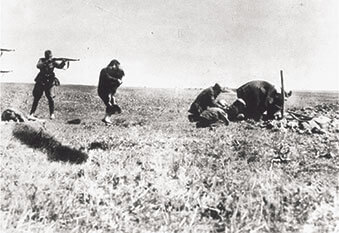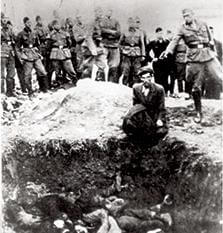
Following the invasion of the Soviet Union, in June 1941, the Einsatzgruppen, operational task forces of German police battalions, and units of the Waffen SS (Armed SS), moved behind German lines to carry out mass murder against Jewish communities, Roma and Communist party officials. They were assisted by local collaborators. The mobile killing units murdered 1 million Jewish men, women and children, and thousands of others deemed enemies of the Reich. At his trial in Nuremberg after the war, Otto Ohlendorf, commander of Einsatzgruppe D, described its operations:
The unit selected would enter a village or city and order the prominent Jewish citizens to call Jews for the purpose of resettlement. They were ordered to hand over their valuables and shortly before execution to surrender their outer clothing. The men, women and children were led to a place of execution, which in most cases was located next to a deeply dug ditch. Then they were shot, kneeling or standing, and their corpses thrown into the ditch.

Ukraine, 1941
Shooting was the most common form of mass murder used by the mobile killing unit. Some complained of mental anguish they experienced shooting women and children. In late 1941, Heinrich Himmler observed the psychological strain that this style of mass murder produced on his men. Consequently, he commissioned his SS technical advisors to test more ‘efficient’ ways of killing and to recommend those which reduced close encounters between executioners and victims. The result was the gas van — a mobile gas chamber mounted on trucks which employed poison carbon monoxide gas, which fed their exhaust into the sealed rear compartment, to kill the victims locked inside.
The Nazis sought and experimented with more efficient killing techniques. Already in 1941 Rudolf Hoess, commander of the Auschwitz-Birkenau concentration camp, had tested hydrogen cyanide gas on 600 Soviet prisoners of war and 250 other prisoners; killing them all in an experimental, stationary gas chamber. In November 1941 a killing site was selected at Chelmo (60 kilometres from the Łodz ghetto), where Jews from Łodz were transported and killed in mobile vans. By early 1942, a stationary and permanent gas chamber was built and operated by people trained within the Euthanasia Program.
In late 1941 Heinrich Himmler asked Odilo Globocnik the SS Police Leader for the Lublin District, with the implementation of Aktion Reinhard (named after Reinhard Heydrich), the systematic murder of Jews living in the Generalgouvernment (Polish captured territory, not incorporated into Germany but administered by a German civilian governor-general). Aktion Reinhard involved the establishment of three killing centres in Poland — Treblinka, Belzec and Sobibor — in which 1.7 million Jews were murdered.
